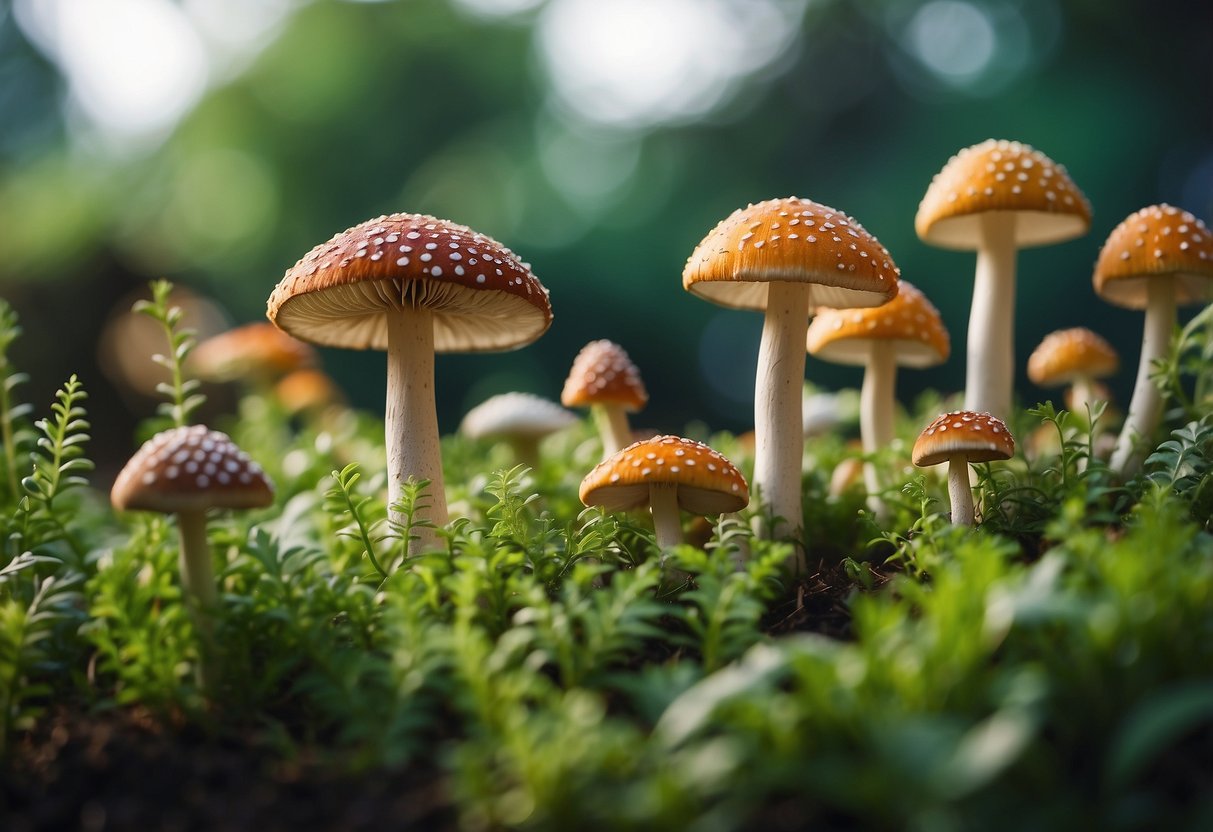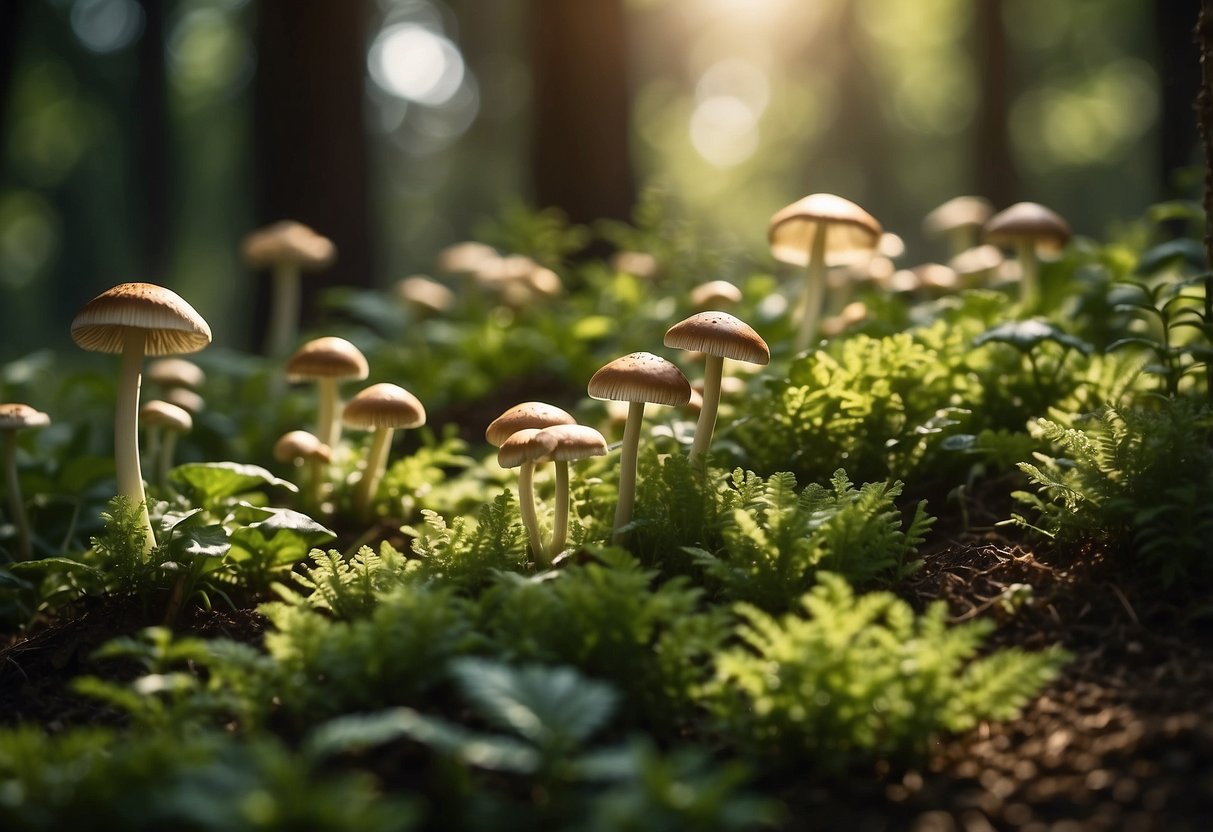Mushroom Garden Ideas: Creative Tips for Your Backyard
Gardening enthusiasts looking for new ideas might find mushroom gardens an exciting option. Whether you’re aiming for a whimsical look or hoping to grow edible varieties, mushroom gardens can add a unique charm to any outdoor space.

Are you wondering how to give your garden a magical touch or even expand your homegrown food options? With a little creativity, you can transform your garden into a delightful area filled with enchanting mushroom displays that will surely impress friends and family.
1) Fairy Ring Pathways

Creating a fairy ring pathway can add a touch of magic to your garden. Use small mushrooms to form a winding path. They come in vibrant colors, adding whimsy to any outdoor space.
Surround the pathway with ferns, moss, or creeping thyme for a dewy ground cover. These plants thrive in shady areas, enhancing the mystical feel of your garden.
2) Mushroom Log Garden

A mushroom log garden is a great way to grow mushrooms at home. You can use logs from trees like oak, birch, or beech.
Start by drilling holes in the logs a few inches apart. Then, insert mushroom spawn into the holes.
Once the logs are inoculated, keep them in a shady, humid spot. After a few months, you’ll see mushrooms sprouting from the logs.
This method is both fun and fruitful. Happy gardening!
3) Whimsical Mushroom Stools

Whimsical mushroom stools add a unique and playful touch to your garden. These stools often feature bright colors and fun patterns, such as polka dots. They’re not just decorative but also functional, providing extra seating.
You can make mushroom stools using materials like painted cardboard spools, felt, and plywood. Check out the detailed steps at Garden Lovers Club. These DIY projects are easy and enjoyable, perfect for adding a whimsical flair to your outdoor space.
4) Glow-in-the-Dark Mushrooms

Imagine your garden lighting up at night. Glow-in-the-dark mushrooms can make this happen. These bioluminescent fungi, like the Green Pepe, emit a soft glow.
Species such as the Little Ping-Pong Bats can be found almost everywhere, except Africa and Antarctica. Adding these to your garden creates a magical ambiance. Learn more about different glow-in-the-dark mushrooms to enhance your outdoor space.
5) Mushroom-Shaped Birdhouses

Mushroom-shaped birdhouses can add a whimsical touch to your garden. They provide shelter for small birds while blending seamlessly with nature. You can find them in various materials like wood, ceramic, and even 3D printed options.
These birdhouses come in vibrant colors and unique designs. If you’re looking for a fairy-tale vibe, try placing a ceramic mushroom birdhouse among your plants. It’s both functional and decorative.
6) Edible Mushroom Patch

Creating an edible mushroom patch in your garden is a rewarding project. Start by selecting a shady, moist spot in your yard.
Use hardwood logs like oak or birch for growing mushrooms. Drill holes into the logs and fill them with mushroom spawn.
Cover the logs with a layer of cardboard and then wood chips. Keep the patch moist to encourage growth.
Soon, you’ll enjoy fresh mushrooms right from your garden, a delight for any home cook. Learn more about starting your own mushroom patch.
7) Mushroom Fountain

Transform your garden into a peaceful retreat with a mushroom fountain. The gentle sound of flowing water will create a soothing atmosphere. It is a unique centerpiece that can add whimsy to any garden.
You can make your own mushroom fountain or buy one ready-made. Either way, it adds a charming touch that attracts birds and butterflies.
8) Miniature Mushroom Houses

Miniature mushroom houses add charm to your garden. They’re perfect for creating fairy gardens or small animal habitats.
You can make one by painting a drainage plate red to serve as the mushroom’s cap. Then, use a small pot for the stem.
Add a tiny door using a piece of acorn as a handle. Check out this DIY guide for more details.
9) Mushroom Garden Stakes

Mushroom garden stakes can add a whimsical touch to your garden. These stakes come in various designs, such as ceramic mushrooms with colorful caps or elegant stained glass mushroom stakes.
You can also find personalized metal mushroom stakes on websites like Etsy. These can be a cute addition to your yard, making it unique and charming.
Consider placing them near pathways or flower beds to draw attention and create a magical atmosphere.
10) Mossy Mushroom Decor

Adding mossy mushroom decor to your garden can create a whimsical and enchanting atmosphere. These decorations bring a natural and fairy-tale-like charm to your space.
You can find mossy mushrooms that are easy to place around your garden. They blend perfectly with plants and add a touch of magic to any spot.
For an inviting look, consider placing mossy mushroom decor near pathways or under trees. It’s a delightful way to enhance your garden’s overall appeal. Explore more ideas for mossy mushroom decor here.
Understanding Mushroom Gardening

Growing mushrooms in your garden is an exciting and rewarding activity. With the right conditions and a bit of care, you can enjoy a bountiful harvest of delicious mushrooms.
Basics of Mushroom Growth
Mushrooms thrive in environments with specific temperature and humidity levels. They are not plants but fungi, meaning they do not need sunlight to grow. Instead, they require a growing medium called substrate, which can be materials like straw, sawdust, or compost. You need to inoculate this substrate with mushroom spawn, which is the starting material for growing mushrooms.
Maintaining the correct moisture level is crucial. Your substrate should be damp but not waterlogged, as too much water can hinder growth. Using a thin layer of soil or straw on top can help retain moisture. Regular watering helps, but be gentle.
Temperature control matters too. Different mushroom species have specific temperature needs, so it’s important to choose varieties that suit your local climate. Good ventilation and a clean environment also play significant roles in successful mushroom growth.
Types of Mushrooms for Gardening
There are several types of mushrooms you can grow in your garden. Each type has different requirements and offers unique flavors. Oyster mushrooms are popular for beginners because they grow quickly and adapt to various substrates like sawdust or straw. They thrive in cooler temperatures and are known for their delicate flavor.
Shiitake mushrooms are another great choice, especially if you like their rich, meaty taste. They typically grow on hardwood logs or sawdust and need a warm and humid environment. This variety takes longer to mature but produces a high yield.
Button mushrooms, including white and cremini, are also widely grown. They require composted manure as their substrate and do best in dark, cool places. These mushrooms are commonly found in grocery stores and are favored for their mild taste.
Choose the mushroom varieties that best match your gardening conditions and personal preferences.
Setting Up Your Mushroom Garden

To set up your mushroom garden, you need to pick the right spot and gather the necessary items. Both steps are key to successful mushroom growth.
Choosing the Right Location
The first thing you need to do is find a suitable spot in your garden. Mushrooms prefer a cool, shaded area with good air circulation. Look for a place under trees or near tall plants that can provide some shade.
Make sure the chosen site is protected from strong winds. Mushrooms need a humid environment to thrive, so avoid dry and windy areas. Consider a location that receives indirect sunlight to prevent the mushrooms from drying out.
If you have a spot with rich, moist soil, that’s a bonus. Mushrooms grow best in well-drained soil that can retain some moisture. Keep in mind that too much sun or overly dry conditions can be harmful to your mushroom garden.
Essential Materials and Tools
Start by gathering the materials you’ll need. You’ll need mushroom spores or spawn, a growing medium like straw, wood chips, or compost, and a moisture-retaining cover like straw or mulch. These items can be found at garden centers or online.
Next, you’ll need tools like a shovel, rake, and a watering can or hose. Use the shovel and rake to prepare your site. Clear away debris and level the ground as needed.
When you have your materials ready, spread the mushroom spores or spawn over the prepared area. Follow this by covering the spawn with a thin layer of the growing medium. Finally, add a layer of straw or mulch on top to help retain moisture and protect the growing mushrooms.
Water the area lightly to keep it damp but not soggy. Regular irrigation is important to maintain the right humidity levels for mushrooms to grow. Make sure not to overwater, as too much water can lead to mold development.
Maintaining a Healthy Mushroom Garden

Proper care of your mushroom garden involves managing water and humidity levels and addressing pests and diseases promptly.
Watering and Humidity Control
Mushrooms thrive in moist conditions. To keep the humidity high, mist the growing area regularly. Use a spray bottle to lightly mist the mushroom bed daily.
Cover the bed with a humidity tent or plastic covering to help retain moisture. Ventilation is critical, so make sure to allow fresh air to circulate, preventing excess moisture, which can lead to mold. Aim for a humidity level around 85-95%.
Check the moisture content of the substrate. It should feel damp but not soggy. Spraying too much water can lead to waterlogging, which is harmful. Adjust watering based on the substrate’s needs.
Dealing with Pests and Diseases
Preventing pests and diseases is vital. If you notice any unusual spots or colors on your mushrooms, act quickly. For instance, green, black, or blue mold indicates contamination and should be removed immediately.
Keep the growing area clean. Use sterilized tools to handle mushrooms. This helps prevent the spread of pests and diseases.
Slugs and insects can damage your mushroom garden. To manage them, use organic repellents or barrier methods like copper tape around the growing area.
Regularly inspect your mushrooms for signs of pests or disease. Early detection can help you address problems before they worsen.







